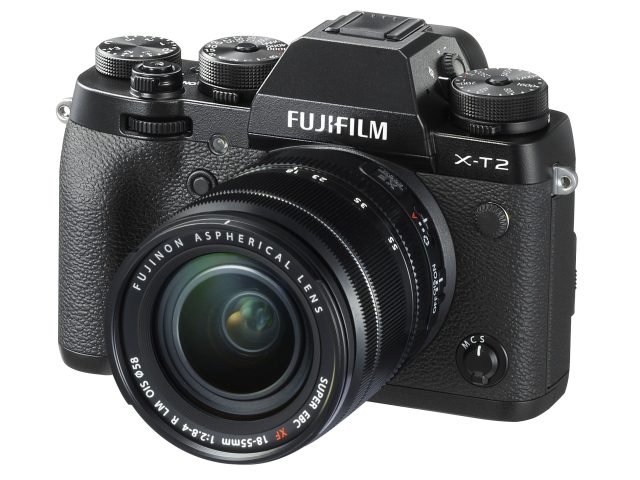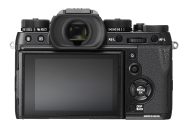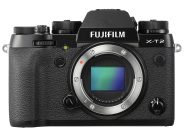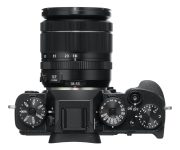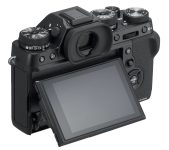Announced
Production status
System
Fujifilm X system cameras
- Fujifilm X-A1
- Fujifilm X-A10
- Fujifilm X-A2
- Fujifilm X-A20
- Fujifilm X-A3
- Fujifilm X-A5
- Fujifilm X-A7
- Fujifilm X-E1
- Fujifilm X-E2
- Fujifilm X-E2S
- Fujifilm X-E3
- Fujifilm X-E4
- Fujifilm X-H1
- Fujifilm X-H2
- Fujifilm X-H2S
- Fujifilm X-M1
- Fujifilm X-Pro1
- Fujifilm X-Pro2
- Fujifilm X-Pro2 Graphite Edition
- Fujifilm X-Pro3
- Fujifilm X-S10
- Fujifilm X-S20
- Fujifilm X-T1
- Fujifilm X-T1 Graphite Silver Edition
- Fujifilm X-T10
- Fujifilm X-T100
- Fujifilm X-T2
- Fujifilm X-T2 Graphite Silver Edition
- Fujifilm X-T20
- Fujifilm X-T200
- Fujifilm X-T3
- Fujifilm X-T30
- Fujifilm X-T30 II
- Fujifilm X-T4
- Fujifilm X-T5
- Fujifilm X-T50
Fujifilm X-T2
APS-C AF digital mirrorless camera • Discontinued
Specification
| Format: | |
| APS-C | |
Imaging sensor: | 23.6 × 15.6mm X-Trans CMOS III sensor |
Resolution: | 6000 × 4000 - 24 MP |
Crop factor: | 1.53x |
Sensor-shift image stabilization: | - |
| Fujifilm X [17.7mm] | |
| Shutter: | |
Type: | Focal-plane |
Model: | Electronically controlled |
Speeds: | 900 - 1/32000 + B |
| Exposure: | |
Exposure metering: | Through-the-lens (TTL), open-aperture |
Exposure modes: | Programmed Auto |
| Aperture-priority Auto | |
| Shutter-priority Auto | |
| Manual | |
| Physical characteristics: | |
Weight: | 507g |
Dimensions: | 132.5x91.8x49.2mm |
Manufacturer description
Valhalla, N.Y., July 7, 2016 – As a leader in advanced digital camera technology and outstanding image quality, FUJIFILM North America Corporation today announced the new FUJIFILM X-T2, a splash-resistant premium interchangeable lens camera with a large OLED electronic viewfinder (EVF). The X-T2 houses the latest generation 24.3MP X-Trans CMOS III with an APS-C sensor with no low-pass filter, boasting the highest performance in the history of X Series. The new X-T2 produces crisp image resolution comparable to that of cameras equipped with larger sensors and higher pixel counts, all in a more compact and classically-designed body.
And for the first time, the new FUJIFILM X-T2 now supports 4K video recording that can use each available Film Simulation mode, including ACROS, to easily produce premium-quality footage that is as unique as the photographer behind the viewfinder.
Dramatic improvement to auto focus system The FUJIFILM X-T2 receives a dramatically improved auto focus system (AF) that increases the overall single AF points to 325, and the number of Zone focusing points to 91 (expanded from 49 in previous models). Approximately 40% of the imaging area (center area containing 49 focusing points) is covered with phase detection auto focus pixels to form a fast and precise phase detection auto focus area that can be used in a variety of scenes.
With the high-speed X-Processor Pro and the use of improved algorithms, the X-T2 now refocuses more frequently, enabling predictive AF of advanced accuracy.
The X-T2 also has an enhanced ability to autofocus on small points of light, low-contrast objects and subjects with fine and delicate textures such as bird feathers and animal fur.
The X-T2’s performance of contrast detection AF, enabled for approximately 65% of the imaging area, has also been improved. The data read speed has been doubled compared to previous models to achieve AF performance of higher speed and precision. Photographers will enjoy accurate focusing is all shooting situations, even in low light with a -3EV.
Another area of improvement is the AF-C algorithm that has been significantly enhanced for even higher accuracy when focus-tracking moving subjects in the AF-C mode. According to the type of movement, users can choose individual settings for Subject Retention Characteristic, Acceleration / Deceleration Tracking Characteristic and Focus Zone Characteristic, or select one of five presets or customize specific settings for these three elements.
Image Quality
Fujifilm’s commitment to superior image quality remains a guiding principle, and the FUJIFILM X-T2 is the latest effort to deliver outstanding picture resolution, all from a compact and sophisticated body that is both weather-sealed and easy to travel with in any location. With Fujifilm’s proprietary image design technology, produced through the development of photographic films, the X-T2 reproduces warm skin tones, bright blue skies and rich green foliage in beautiful colors, just as you remember seeing in real life. The X-T2 includes the ACROS Film Simulation for smooth gradation, deep blacks and beautiful textures to create monochrome images that far outperform even the most demanding expectations.
The X-T2 also has the Grain Effect function for reproducing distinctive graininess seen in photographs taken with film cameras. The function is available in Strong and Weak options, and can be combined with any of the Film Simulation modes. You can easily obtain the effect of film-based photos, notable especially when the image is printed out.
Speedy throughout
Basic response specifications, such as startup time, shooting interval and shutter release time lag, have all been improved to the extreme in pursuit of a camera that operates exactly as the photographer demands. The high-speed processing power and the use of improved algorithms have significantly improved the basic autofocus performance, and X-T2 now gives users AF-C Custom Settings for even higher accuracy in focus-tracking moving subjects.
The X-T2’s electronic viewfinder, which is used to continuously track a moving subject, is capable of displaying up to 100 frames per second, while also maintaining the magnification ratio of 0.77x and the display time lag of 0.005 seconds. The duration of the viewfinder blackout, in which the evf blacks out temporarily while the camera reads picture data, has been reduced by more than half, enabling continuous shooting to ensure tracking subject movements.
Body and grip offer ultimate stability
The X-T2’s body is fully made of magnesium alloy making it not only compact and lightweight, but also solid and highly durable. The X-T2 body has weather-proofing at 63 points to achieve a high level of resistance to dust and moisture, and coupled with its ability to operate in temperatures down to 14°F, is ready for full-fledged field photography. Similar ruggedness is applied to the new Vertical Power Booster Grip.
The Vertical Power Booster Grip (optional VPB-XT2) is a dust-resistant grip, rugged and capable of operating at temperatures as low as 14°F that maximizes the performance of the X-T2 beyond expectations. It fits two batteries, bringing the total number of batteries the X-T2 can use to three, including the one in-camera, to increase the maximum number of frames that can be taken per charge to approximately 1,000 (Normal mode). In the Boost mode, multiple batteries can operate at the same time to give a boost to camera performance in continuous shooting, shooting interval, shutter release time lag and blackout time, while also extending the duration of 4K video recording to approximately 30 minutes.
The Vertical Power Booster Grip also features a shutter release button, focus thumbstick, AE-L button, AF-L button, command dials, Q button and Fn button and headphone jack to enable audio monitoring during video recording to provide the same level of excellent operability in vertical shooting as you get in horizontal operation. The grip itself has battery-charging functionality where by using the AC adapter supplied (AC-9VS), users can fully charge two batteries at the same time in about two hours.
FUJIFILM X-T2 key features:
- 24.3MP X-Trans CMOS III Sensor
- Dust and moisture-resistant body with approximately 63 points of weather sealing; Freeze resistance to 14°F
- X-Processor Pro
- Fast AF of 0.06 seconds
- Startup time of 0.3 seconds
- Shutter time lag of 0.045 seconds
- Shooting interval of 0.17 seconds
- Phase detection AF and motion predictive AF for continuous shooting up to 8 frames per second (fps)
- Up to 11fps using Booster Grip
- High-precision 0.48-inch, 2.36 million dot OLED viewfinder
- Viewfinder magnification for digital cameras of 0.77x
- Wide viewing angle (diagonal 38° and horizontal 31°)
- Ultra-fast Real Time Viewfinder with a lag-time of 0.005sec (less than 1/10 of existing models)
- Automatic Brightness Adjustment function
- EVF refreshes at a rate of 60fps, or as high as 100fps in the Boost mode
- Continuous shooting of 5fps in Live View
- Full 4K 3840x2160 30P/25P/24P shooting (Using a card with the UHS Speed Class 3 or higher)
- Continuous recording: up to approximately 10 minutes
- Full HD 1920x1080 60P/50P/30P/25P/24P, Continuous recording: up to approximately 15 minutes
- HD 1280x720 60P/50P/30P/25P/24P, Continuous recording: up to approximately 29 minutes
- Four different display modes: Full, Normal, Dual and Vertical
- Full mode: Displays shooting information at the top and bottom of the screen to avoid obstruction of the view
- Dual mode: Adds a small second screen for checking focus point with Focus Peak Highlight or Digital Split Image
- Normal mode: Lets you concentrate on framing the shot in Auto Focus mode while keeping you aware of how the shooting conditions are changing, making it the perfect setting for sports and action photography
- Portrait mode: When in Full or Normal modes, it rotates the shooting information interface when the camera is turned vertically
- Tempered glass 1.04 million dot high-precision 3” tilting LCD monitor
- Digital Split Image and Focus Highlight Peaking
- Wi-Fi and remote camera operation
- ISO200 - 6400, extended ISO 100, 12800, 25600, Auto(maximum ISO setting from ISO 400 – ISO6400 available) with High ISO 51200 setting
- Lens Modulation Optimizer technology maximizes each lens’ performance
- In-camera RAW converter
- Die-cast magnesium body provides a sturdy and durable, while compact and lightweight design
- Two command dials and six Function buttons for instant control and customization
- Interval timer shooting for Time Lapse photography is available with intervals of 1 second to 24 hours and up to “∞” frames
- Advanced filters and Film Simulations, including ACROS
